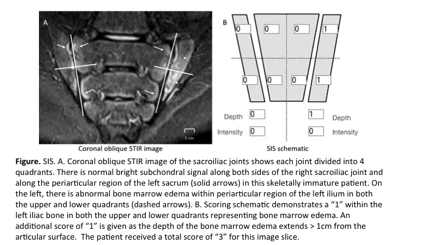Session Information
Session Type: ACR Poster Session B
Session Time: 9:00AM-11:00AM
Background/Purpose
: We lack a method to quantify severity of inflammation in the pediatric sacroiliac joint. We evaluated the reliability and construct validity of the Spondyloarthritis Research Consortium of Canada (SPARCC) sacroiliac joint inflammation score (SIS) in children with suspected or confirmed juvenile spondyloarthritis (SpA).Methods
: The SIS divides the joint into quadrants and scores the presence, depth, and intensity of bone marrow edema (BME) on short tau inversion recovery (STIR) magnetic resonance imaging (MRI). Six consecutive semicoronal slices through the cartilaginous portion of the joint are scored for BME (total score 0-72). We developed a pediatric training module that included scoring instructions and examples of BME and bright subchondral signal on STIR scans easily confused with inflammation (Figure). After reviewing the module, 5 readers (1 adult and 3 pediatric radiologists, 1 adult rheumatologist), blinded to clinical details except age, scored 30 studies that included semicoronal T1-weighted and STIR sequences. Pain was recorded on a visual analogue scale (0-10). Disease activity was evaluated using the juvenile SpA disease activity (JSpADA) index (range 0-8). Inter-observer reliability was assessed using intraclass correlation coefficient (ICC). Correlation (convergent validity) of the mean SPARCC SIS developers’ score with disease activity was tested using Spearman correlation. Discrimination was tested by comparing the mean SPARCC SIS developers’ score between children with and without inflammatory back pain using the Mann-Whitney test.Results
: The SIS had face validity and was feasible to score in the 30 pediatric cases. 21 (70%) were male. Median age at the time of imaging was 15.5 years (IQR: 12.7-16.8). Median pain score and JSpADA index were 2 (IQR 0.5-6) and 2 (IQR: 0.5-3), respectively. Of the 150 scores submitted by 5 readers, 114 (76%) of the studies had a SIS >2. Median SIS was 13.5 (IQR: 2-28). ICC for all readers (N=5), SPARCC developers (N=2), and pediatric radiologists (N=3) were 0.69 (95% CI: 0.47-0.83), 0.89 (95% CI: 0.75-0.95), and 0.85 (95% CI: 0.72-0.92), respectively. SIS had low correlation with disease activity as measured by the JSpADA (r=-0.08) and C-reactive protein (r=0.14). SIS score did not discriminate between those with and without inflammatory back pain (p=0.16).Conclusion
: The SIS was feasible to score and had near excellent reliability, even with limited calibration. SIS did not have convergent validity with clinical measures of disease activity, highlighting that imaging and clinical evaluations provide complimentary but non-overlapping information. Responsiveness of the SIS should be evaluated in a prospective cohort of children who start biologic therapy.
Disclosure: N. A. Chauvin, None; W. P. Maksymowych, None; R. G. Lambert, None; J. Jaremko, None; D. M. Biko, None; T. G. Brandon, None; J. Paschke, None; P. F. Weiss, None.
To cite this abstract in AMA style:
Chauvin NA, Maksymowych WP, Lambert RG, Jaremko J, Biko DM, Brandon TG, Paschke J, Weiss PF. Feasibility and Reliability of the Spondyloarthritis Research Consortium of Canada Sacroiliac Joint Inflammation Score for Children with Spondyloarthritis [abstract]. Arthritis Rheumatol. 2016; 68 (suppl 10). https://acrabstracts.org/abstract/feasibility-and-reliability-of-the-spondyloarthritis-research-consortium-of-canada-sacroiliac-joint-inflammation-score-for-children-with-spondyloarthritis/. Accessed .« Back to 2016 ACR/ARHP Annual Meeting
ACR Meeting Abstracts - https://acrabstracts.org/abstract/feasibility-and-reliability-of-the-spondyloarthritis-research-consortium-of-canada-sacroiliac-joint-inflammation-score-for-children-with-spondyloarthritis/

